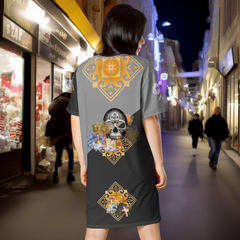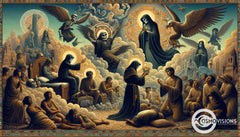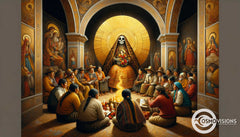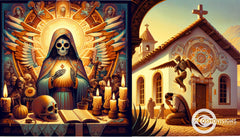The Rise of Santa Muerte: A Folk Saint in Mexican Folk Catholicism and Neopaganism
Posted by Luciano Martucci
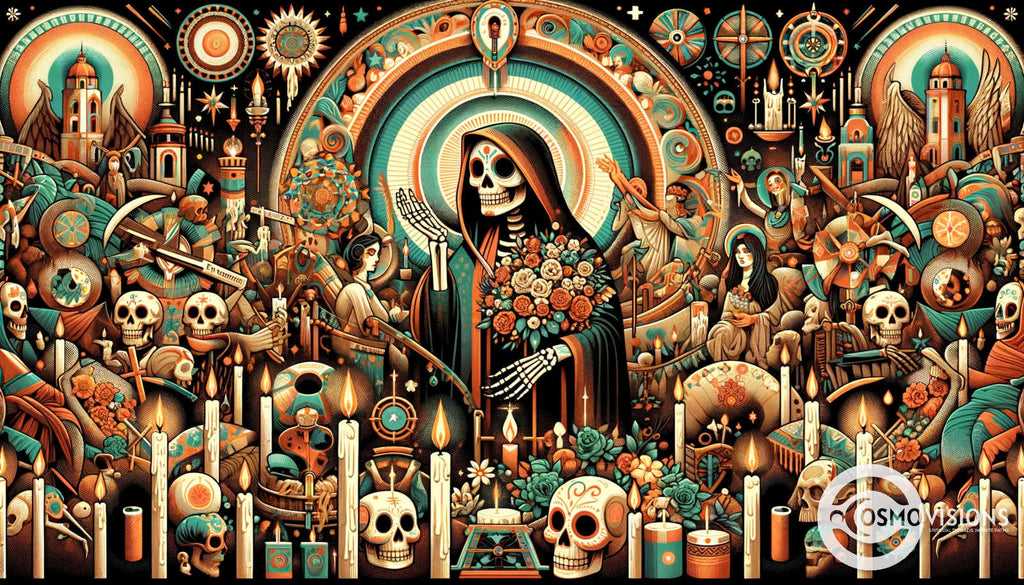
La Santa Muerte has complex origins deeply intertwined with Mexican culture and history. Originating from indigenous Mesoamerican beliefs, the cult of Holy Death also draws on European Catholic traditions brought by Spanish conquistadors.
Over time, La Santa Muerte evolved into a syncretic faith blending pre-Hispanic spirituality with folk Catholicism. This fusion created an enigmatic figure that embodies both devotion and fear in Mexican society.
As we delve deeper into La Santa Muerte's intricate origins, it becomes evident that her multifaceted nature represents a response to societal complexities, serving as an instrument for empowerment among those at the margins. These origins underscore how this religious figure has become a symbol of resistance against social injustices and historical struggles unique to Mexico.
Role in Modern Society
La Santa Muerte's influence reaches far beyond her historical roots, playing a pivotal role in addressing the contemporary concerns and challenges of society. Andrew Chesnut notes that this folk saint is considered as one of the fastest-growing religious movements in North America, becoming an integral part of Mexican folk Catholicism and neopaganism. As a beacon for those who feel marginalized or unprotected, she offers spiritual solace to scores of believers.
Her appeal cuts across various groups, including undocumented migrants seeking guidance and LGBTQ+ individuals searching for acceptance outside conventional religious spaces.
Her veneration reflects an urgent need among followers for protection against both metaphysical and worldly hardships. In times of social unrest or personal struggle, devotees turn to La Santa Muerte for comfort and a sense of order.
This is especially true for communities facing threats from crime, discrimination or inequalities enforced by dominant cultural norms. Through rituals, prayers and community gatherings surrounding this powerful folk saint, people find strength and solidarity to navigate the complexities of modern life.
Importance in Mexican Folk Catholicism
Mexican Folk Catholicism blends indigenous traditions with colonial-era religious practices, and La Santa Muerte stands as a powerful symbol in this fusion. She embodies the resilience of belief systems that have adapted over centuries, merging pre-Hispanic spirituality with Catholic tenets.
As a saint recognized by a large part of the population, she has secured a significant place among many Mexicans who feel disconnected from the official church yet seek solace in familiar spiritual figures. Her followers turn to her for help with matters overlooked by traditional saints—desires and problems often considered too taboo or desperate.
La Santa Muerte's devotees come from diverse backgrounds, finding common ground in their reverence for her as a protector and provider. They see her not only as La Parca, an iteration of the Grim Reaper but also as an entity akin to the Virgin of Guadalupe: compassionate and merciful.
This duality is essential to understanding how deeply ingrained she is within Mexican spirituality, transcending mere superstition to become part of daily life for millions seeking guidance and protection outside conventional channels. Her importance reveals much about contemporary spiritual needs in Mexico’s ever-evolving cultural landscape, seamlessly transitioning us into exploring how colors play into La Santa Muerte symbolism.
The Connection Between La Santa Muerte Followers and Christianity
La Santa Muerte rituals closely resemble standard Catholic practices. Many La Santa Muerte followers identify as fully practicing Catholics. The syncretic origins of the La Santa Muerte movement indicate its connection to the Christian faith.
Believers have a La Santa Muerte figurine in their homes which they decorate, dress, talk and pray to, indicating a strong connection to religious practices. The rituals and prayers to La Santa Muerte are nearly identical to standard Catholic practice, suggesting a strong influence of Christian beliefs in the worship of La Santa Muerte.
The cult of La Santa Muerte incorporates elements of New Age spirituality, folk Catholicism, and religious bricolage, highlighting its connection to Christianity and other religious traditions.
Understanding the seamless blend between La Santa Muerte followers and Christianity is essential for comprehending the cultural significance behind these spiritual practices.
Land Acknowledgement
La Santa Muerte has deep ties in Mexican culture, particularly those chased away from their ancestral lands. The veneration of La Santa Muerte intersects with indigenous beliefs and folk Catholicism, reflecting a profound connection to the land and its spiritual significance.
As the new fastest-growing religious movement in the Americas, the worship of La Santa Muerte significantly impacts cultural and spiritual landscapes, including its relationship to the land. Widely revered as a protector to those who worship her, she is not viewed as a symbol of Satanism but rather as an essential divine worker under God’s guidance.
With her association with security and protection for the marginalized or displaced, there exists a complex understanding of spirituality that reflects reverence toward both natural elements such as land and human experiences."
Law enforcement officials in Vatican and in the United States have associated La Santa Muerte's worship with criminal activities such as drug trafficking and illicit behavior. This has led to discussions about how her presence may be affecting social dynamics and moral values within communities.
Moreover, scholars believe that her popularity in the United States reflects a blending of traditions between Mexican culture and American society. The impact of La Santa Muerte raises questions about how different belief systems interact and shape cultural landscapes within diverse societies like that of America.

Opposition from Church and State
The Catholic Church loudly challenges the veneration of La Santa Muerte, condemning it as contrary to Christian doctrine. High-ranking officials, including Cardinals and Bishops, have publicly denounced practices related to La Santísima Muerte as dangerous and idolatrous, threatening devotees with excommunication.
They argue that such worship runs against the core teachings of Christianity and diverts the faithful from seeking intercession through officially recognized saints.
Leaders within the Mexican government also voice concerns over La Santa Muerte's association with criminal elements. Law enforcement agencies see her as a figure revered by those involved in narcotics trafficking and other illegal activities.
This has led to a clash between traditional law measures and cultural expressions among marginalized communities who find solace in their faith for La Parca.
Church Opposition
The Catholic Church has consistently condemned the devotion to La Santa Muerte as blasphemous and satanic, actively opposing its worship in Mexico and Latin America. Despite being a prominent figure in Mexican folk Catholicism and neopaganism, La Santa Muerte faces significant opposition from the traditional religious establishment. The church's stance is evident in its condemnation of La Santa Muerte as satanic, a stark contrast to its acceptance of more established Mexican saints.
Moreover, throughout the mid-20th century and into the 21st century, discrimination against La Santa Muerte worshipers has been prevalent. Church authorities have openly labeled devotion to La Santa Muerte as contrary to Catholic doctrines while dismissing it as idolatrous practice.
La Santa Muerte holds a complex relationship with Catholic faith, blending indigenous beliefs with elements of Catholicism. Despite opposition from the Church, many La Santa Muerte devotees still consider themselves Catholics and honor traditional saints alongside La Santa Muerte.
State Opposition
Despite the Catholic Church's condemnation of La Santa Muerte, state opposition has also played a significant role in attempting to suppress her worship. Since the mid-20th century, authorities have been quick to denounce and persecute followers of La Santa Muerte, viewing the saint as a threat to social order and religious orthodoxy.
The cult's fusion of pre-Hispanic beliefs with Catholic rituals has led to resistance from state institutions, which often perceive it as an affront to their authority. This opposition has been particularly evident in contemporary US responses to undocumented migrants, where La Santa Muerte worship is seen as a challenge to established norms.
La Santa Muerte's veneration as a folk saint and female deity in Mexican Neopaganism has sparked conflict and opposition from traditional religious institutions such as the Catholic Church.
LGBTQ+ Community
La Santa Muerte plays a significant role in the LGBTQ+ community, serving as a protector and symbol of acceptance for homosexual, bisexual, and transgender individuals. It is not uncommon for La Santa Muerte to be invoked during same-sex marriage ceremonies in Mexico, reflecting its association with diverse expressions of love and relationships.
Furthermore, there's a network of LGBTQ+ leaders who sustain and organize La Santa Muerte worship in Mexico, which highlights the bond between this deity and marginalized communities.
The growing devotion among Mexican transgender persons underlines the widening gap between LGBTQ+ individuals and traditional religious establishments.
The queer performance scene and studies within the realm of religion emphasize how La Santa Muerte has become an important figure for promoting inclusivity within the LGBTQ+ community.
In addition to being associated with the LGBTQ+ community, La Santa Muerte offers protection and guidance across various walks of life. Followers from different backgrounds seek her intercession for safety and support in their daily lives, reflecting the universal appeal of her protective nature.
From marginalized individuals living outside traditional religious structures to those seeking solace in times of hardship, people turn to La Santa Muerte as a source of comfort and empowerment.
La Santa Muerte's devotees come from diverse sectors, including those who feel disconnected from mainstream religions or society. They find solace in her inclusive and comforting presence, drawing strength from her role as a protector of all people regardless of their circumstances.
The Modern Need for Security
In today's complex world, the modern need for security has spurred the worship of La Santa Muerte. As people face increasing uncertainty and challenges in their daily lives, they seek spiritual guidance and protection from unofficial icons like La Santa Muerte.
This enigmatic figure has become a source of hope for many who feel marginalized and overlooked, offering a sense of security and solace in tumultuous times.
The expansion of organized crime has further fueled the belief that La Santa Muerte is part of a coherent "narco-culture" adding to its mysterious identity. With investigative support programs for La Santa Muerte-related killings emerging nationally, there is a growing need for understanding and addressing the influence of La Santa Muerte in modern culture.

Association with criminality
Given the association of La Santa Muerte with the LGBTQ+ community, it's crucial to address another significant but controversial aspect linked to this religious figure. La Santa Muerte's association with criminality is a contentious aspect of the tradition, as some variants of the cult are linked -according to the mass media- to increased criminal behavior. Particularly, the image of La Santa Muerte has been connected to organized crime and narcotraffickers, resulting in a perception that La Santa Muerte is closely linked with illegal activities. U.S. law enforcement officers have associated La Santa Muerte with nefarious activities such as drug cartels and ritualistic killings.
Devotees are known to make cash offerings at altars dedicated to La Santa Muerte, considering them sacred. This association has led to the belief that narco saints' influence (the influence of narco saints (such as Saint Jude Thaddeus, or Jesus Malverde) is linked with criminal entities and dark rituals, adding a layer of complexity to the religious practices surrounding La Santa Muerte.
This has led to a tarnished reputation for La Santa Muerte, sparking academic discussions that delve into the sociological aspects of this association with criminals. Furthermore, there is an underlying belief among some that Santa Muerte contributes to an increase in crime rates, with specific associations made between La Santa Muerte and organized crimes such as robberies and narcotrafficking.
The presence of Malverde figure further deepens these perceptions as being associated with criminality in the context of La Santa Muerte celebration. However, it’s important to recognize that these associations do not represent all practitioners or aspects of this complex spiritual tradition but deserve cautious consideration when exploring its societal impact.
The Story of Jesús Malverde: Mexican Folk Saint
Jesús Malverde, a revered figure in the folklore of Sinaloa, Mexico, is often depicted as a "generous bandit" and "angel of the poor". His legendary tale chronicles his orphaning and subsequent turn to robbing the affluent to support the less fortunate. This narrative has elevated Malverde to a symbol of economic assistance among Mexicans, leading many to place their trust in his influence for financial help.
The story surrounding Jesús Malverde's demise adds depth to his status as a saint chosen by the people. While the specifics are steeped in legend, his death is considered an essential part of his enduring appeal. This popular hero's devotion continues to gain traction across various sectors of Mexican society, embodying hope for those seeking economic relief amidst adversity.
The Controversy Surrounding La Santa Muerte
The controversy surrounding La Santa Muerte stems from its dualistic nature, aiding both those considered "good" and "bad" by mainstream society and religion. This has sparked a debate about the implications of venerating a figure that transcends traditional moral boundaries.
Additionally, the spread of La Santa Muerte's veneration is seen as controversial due to its female personification of the Grim Reaper, challenging established patriarchal norms. Furthermore, some followers consider themselves Catholic but have lost faith in traditional saints such as Saint Jude, leading to conflicts within religious communities.
Moreover, an impoverished family of La Santa Muerte devotees in northern Mexico committed a shocking crime by killing three acquaintances and offering their blood to the saint of death. This event intensified debates surrounding the ethics and consequences of devotion to La Santa Muerte, presenting significant challenges for understanding its role within contemporary spiritual practices.
The cult has been associated with sensationalized crimes in Mexico and has garnered attention due to its involvement in crime scenes featuring altars and ritualistic activities. This connection between criminality and the worship of La Santa Muerte is a complex aspect that continues to spark interest and controversy among followers, law enforcement agencies, and researchers.
Involvement in this form of worship can lead individuals down paths that blur moral boundaries, ultimately leading them into conflict with legal authorities. The allure of power and fulfillment of desires through religious practices may create an environment where illicit actions are seen as justified or necessary for personal gain.
Rise to Popular Attention in the 1990s and Beyond
La Santa Muerte experienced a surge in popularity and visibility during the 1990s, becoming one of the fastest-growing religions across the Americas. This rise to prominence challenged traditional religious norms, drawing followers from diverse backgrounds beyond just Hispanic and Latino communities.
The controversial ascent of La Santa Muerte brought it into direct conflict with the Catholic Church in Mexico. As widespread attention increased, so did controversy surrounding this enigmatic figure.
The 1990s marked a turning point for La Santa Muerte's public perception as it garnered attention not only within Mexican culture but also beyond its borders. The appeal of La Santa Muerte was propelled by societal shifts and has since engaged followers across different social spheres, causing significant tension with established religious entities.
The Role of La Santa Muerte in Popular Culture
Moving from the historical and founding aspects of public shrines dedicated to La Santa Muerte, it is vital to acknowledge the role of this revered figure in popular culture. La Santa Muerte has garnered attention in art, literature, film, and music, symbolizing a complex fusion of religious and cultural elements.
From visual art depicting her as a powerful female deity to musical references acknowledging her omnipresence in Mexican folklore, La Santa Muerte holds an undeniable place in popular culture.
Various artists have depicted La Santa Muerte through striking imagery that not only captures her traditional iconography but also reflects contemporary interpretations. The influence of La Santa Muerte can be observed across different mediums - she permeates popular media while embodying diverse meanings for individuals within Mexican communities alike.

La Santa Muerte in the Time of Coronavirus
Amid the pandemic, La Santa Muerte has risen as a powerful saint with remarkable faith healing abilities. She is being venerated for her curative powers and protective blessings in response to COVID-19.
Often overlooked by mass media, La Santa Muerte's role in faith healing and acceptance of death during this time plays a vital part in the spiritual practices of many individuals. Her influence extends beyond associations with narcosaints, establishing her reputation as a powerful figure for healing and protection amidst various crises.
Folk saints like La Santa Muerte have gained prominence in recent times due to their perceived ability to aid in alleviating suffering and providing hope during challenging circumstances.
The Angel of Death as Defender of Front Line Workers
La Santa Muerte has emerged as a revered figure, particularly among front line workers during the pandemic. Many have turned to her for protection and healing amidst these challenging times, seeking solace in her association with healing, protection, and safe passage to the afterlife.
The saint's devotees view her as a defender of those battling on the front lines against coronavirus, showing an unwavering belief in her ability to provide safeguarding support. Front line workers across various disciplines continue to find reassurance and hope through their devotion to La Santa Muerte. They perceive her as a powerful force capable of shielding them from harm and providing comfort during this time of uncertainty.
Attitudes to Death in a Time of Coronavirus
As the COVID-19 pandemic continues to impact communities worldwide, attitudes toward death have evolved. La Santa Muerte, revered as a symbol of protection and hope in times of crisis, has garnered increased devotion during the pandemic.
Believers turn to the saint not only for defense against the virus but also for emotional healing and support through challenging times. The experience of rebirth that is central to La Santa Muerte rituals offers solace and comfort amidst the uncertainties brought on by the pandemic.
In this time of coronavirus, devotees find reassurance in their faith in La Santa Muerte, seeking miracles and blessings to safeguard themselves and their loved ones. The saint's significance has extended beyond traditional beliefs surrounding death, presenting a unique perspective on mortality during these uncertain times.
La Santa Muerte in Popular Culture
La Santa Muerte has made its presence felt in popular culture through its representation in music, art, and portrayal in various media forms. To explore the influence of this saint further, continue reading to gain a deeper understanding of La Santa Muerte's impact on modern society.
Representation in Music and Art
Art and music play a significant role in representing La Santa Muerte, with numerous songs and artworks dedicated to her. The depictions of La Santa Muerte in music and art showcase the blending of pre-Hispanic traditions with Catholic rituals within popular culture.
These representations often portray her as a skeletal figure holding symbols like like a globe, a scale, a book, a lamp in one hand and a scythe in the other, symbolizing her dualistic nature.
Many musicians have composed songs honoring La Santa Muerte, reflecting the fusion of indigenous beliefs with Catholicism through captivating lyrics and melodies. Similarly, artists use different mediums to visually depict La Santa Muerte's duality as both a protector and an advocate for safe passage into the afterlife.
Portrayal in Media
Mexican media has widely portrayed La Santa Muerte, depicting her striking image and widespread influence. She is often represented as the patron saint of the cartels and a premier symbol of narcoculture, reflecting her controversial and complex identity in popular culture.
La Santa Muerte's portrayal in Mexican media serves as a reflection of her significance within contemporary Mexican society, highlighting her connection to various subcultures and social movements while also contributing to her growing presence in global consciousness.








